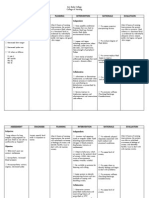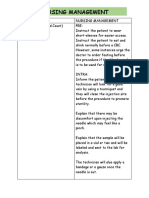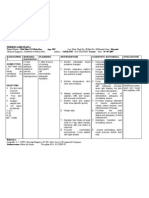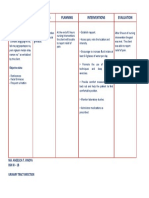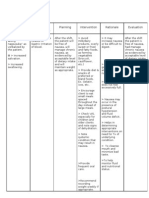NCP Dysuria
NCP Dysuria
Uploaded by
Jerico Geronimo DacutCopyright:
Available Formats
NCP Dysuria
NCP Dysuria
Uploaded by
Jerico Geronimo DacutOriginal Title
Copyright
Available Formats
Share this document
Did you find this document useful?
Is this content inappropriate?
Copyright:
Available Formats
NCP Dysuria
NCP Dysuria
Uploaded by
Jerico Geronimo DacutCopyright:
Available Formats
CUES/ NURSING DX Risk factors for interstitial cystitis/painful bladder syndrome.
SCIENTIFIC ANALYSIS Dysuria is painful urination. This pain, discomfort or burning sensation during urination is actually a common problem. Dysurias burning pain is often caused by some sort of infection, but not always. Something pressing against your bladder or stuck near its entrance can be a cause for painful urination. This type situation may occur if you have an ovarian cyst or kidney stone. If a urinary tract infection, gonorrhea or chlamydia is the likely cause for your burning dysuria, appropriate antibiotics may be prescribed ahead of lab test confirmation.
OBJECTIVES After 8 hours of nursing intervention, the patient will reduce pain scale of 7 to 4. (-) sunken eyes
NURSING INTERVENTIONS 1. Record urinary output; investigate sudden reduction/cessation of urine flow. 2. Encourage increased fluids & maintain accurate fluids. 3. Monitor BP & HR.
RATIONALE 1. Sudden decrease in urine flow may indicate obstruction/ dysfunction or dehydration. 2. Maintain hydration & good urine flow. 3. Orthostatic hypotension & tachycardia suggest hypovolemia. 4. Decreased flow may reflect urinary retention with increase pressure in Upper Urinary Tract. 5. Relieve pain enhances comfort & promotes rest.
EVALUATION
Signs & Symptoms: Subjective: Maul-ul tak likod as verbalized by the patient & rated at the pain scale of 7 out of 10. Objectives: T= 36.2 C BP= 100/60 mmHg P=67 bpm R=20 cpm (+) good skin turgor (+) moist mucous membranes (+) stable weight & VS (+) sunken eyes (+) conscious (+) clear speech
4. Note urine flow & characteristics.
Ref: Brunner & Suddarths Medical-Surgicaal Nursing (Volume 2)
5. Administer medication as indicated eg. Analgesic & antibiotcs. 6. Monitor laboratory studies.
6. To indicate urinalysis status.
You might also like
- Risk For Deficient Fluid Volume Best NCPDocument2 pagesRisk For Deficient Fluid Volume Best NCPAlbean DelojeroNo ratings yet
- NCP - Risk For InfectionDocument2 pagesNCP - Risk For InfectionJet Bautista100% (1)
- Risk For Acute ConfusionDocument2 pagesRisk For Acute ConfusionChar PereaNo ratings yet
- Nursingcrib Com NURSING CARE PLAN Hepatitis ADocument2 pagesNursingcrib Com NURSING CARE PLAN Hepatitis APravesh Verma100% (1)
- NCP - Fluid RetentionDocument3 pagesNCP - Fluid RetentionMichelle Teodoro100% (1)
- Case of DiverticulitisDocument5 pagesCase of DiverticulitisFuture RN100% (1)
- Iii. Nursing Care PlansDocument13 pagesIii. Nursing Care PlansLharra Cagulada-Postrano100% (1)
- NCP 28Document9 pagesNCP 28Leanne Joie Lozano100% (1)
- NCP PROPER Pain and Decreased Cardiac OutputDocument3 pagesNCP PROPER Pain and Decreased Cardiac OutputErienne Lae Manangan - CadalsoNo ratings yet
- NCP FeverDocument2 pagesNCP FeverRic Velasco100% (2)
- NCP (Deficient Fluid VolumeDocument3 pagesNCP (Deficient Fluid VolumeNica RespondoNo ratings yet
- Nursing Care Plan On Foul-Smelling LochiaDocument3 pagesNursing Care Plan On Foul-Smelling LochiaNE Tdr100% (1)
- Nursing Care Plan 1Document12 pagesNursing Care Plan 1Disyme Duron AzuresNo ratings yet
- Diarrhea NCPDocument3 pagesDiarrhea NCPCharles Michael Azagra0% (1)
- NCP LymphomaDocument3 pagesNCP Lymphomamahmoud fuqahaNo ratings yet
- NCP LymphomaDocument3 pagesNCP LymphomaJohn Emmanuel Tatad TudNo ratings yet
- NCP GbsDocument2 pagesNCP GbsJaylord VerazonNo ratings yet
- NCP and DSDocument6 pagesNCP and DSfranzcatchie100% (1)
- "Nagtatae Siya 4 Days Na" As Verbalized by The Mother. Inatake of Causative Agents Irritation of The Stomach Inflammation of The Stomach Increase GI Motility DiarrrheaDocument4 pages"Nagtatae Siya 4 Days Na" As Verbalized by The Mother. Inatake of Causative Agents Irritation of The Stomach Inflammation of The Stomach Increase GI Motility DiarrrheaMelissa MhelNo ratings yet
- Deficient Knowledge Related To Urinary Tract Infection: "Di Ako Aware About Sa UTI"as Verbalized by The ClientDocument2 pagesDeficient Knowledge Related To Urinary Tract Infection: "Di Ako Aware About Sa UTI"as Verbalized by The ClientSeanmarie CabralesNo ratings yet
- NCPDocument14 pagesNCPclaidelynNo ratings yet
- NCP FVDDocument2 pagesNCP FVDMarlon AnryNo ratings yet
- NCP Ruq PainDocument3 pagesNCP Ruq PainKristine YoungNo ratings yet
- NCP Uterine Myoma Ni ZDocument2 pagesNCP Uterine Myoma Ni ZZorroaster Yasol100% (3)
- CARAGAN, Chantal Herpes Zoster Assessment Diagnosis Planning Interventions Rationale Evaluation Subjective: Short Term: Independent: Short TermDocument4 pagesCARAGAN, Chantal Herpes Zoster Assessment Diagnosis Planning Interventions Rationale Evaluation Subjective: Short Term: Independent: Short TermChantal Caragan100% (2)
- Nursing NCP Acute GastroenteritisDocument8 pagesNursing NCP Acute GastroenteritisWinnie AriolaNo ratings yet
- Final NCP LeptospirosisDocument6 pagesFinal NCP LeptospirosisKeith Austin100% (1)
- Nursing ManagementDocument19 pagesNursing ManagementAjie ZamNo ratings yet
- CystoclysisDocument2 pagesCystoclysisRaymond BasiloniaNo ratings yet
- Fluid Volume Deficit Secondary To Post Partum HemorrhageDocument3 pagesFluid Volume Deficit Secondary To Post Partum HemorrhagePatricia Franco100% (1)
- NCP GastroenteritisDocument1 pageNCP GastroenteritisFranchesca PaunganNo ratings yet
- Nursing Care Plan: IndependentDocument2 pagesNursing Care Plan: IndependentAdhaNo ratings yet
- Diabetes Mellitus (DM)Document1 pageDiabetes Mellitus (DM)Bheru LalNo ratings yet
- Nursing Care Plan Urinary Tract Infection UTIDocument2 pagesNursing Care Plan Urinary Tract Infection UTITrida Hermano CabansagNo ratings yet
- Acute GastroenteritisDocument2 pagesAcute GastroenteritisErika CadawanNo ratings yet
- NCP HemothoraxDocument3 pagesNCP Hemothoraxroseonabreeze0% (2)
- Nursing Care Plan Renal FailureDocument2 pagesNursing Care Plan Renal FailureMark Jason Rabadan100% (1)
- Nursing Care Plan: Subjective DataDocument4 pagesNursing Care Plan: Subjective DataAbdallah AlasalNo ratings yet
- NCP SEIZURE DISORDERDocument2 pagesNCP SEIZURE DISORDERPatricia FaraonNo ratings yet
- NCP Post TermDocument2 pagesNCP Post TermFhairy Jhoy Rhayta100% (1)
- Thyroidectomy NCPDocument1 pageThyroidectomy NCPkzbreakerrNo ratings yet
- Nursing Care Plan (DF)Document1 pageNursing Care Plan (DF)LR B BayatoNo ratings yet
- Uti NCPDocument1 pageUti NCPAngelique Vinoya100% (2)
- Hyperthermia NCPDocument2 pagesHyperthermia NCPMatthew Emmanuel M. Martinez0% (1)
- NCP UtiDocument1 pageNCP UtiElaisa Mae Delos SantosNo ratings yet
- Difficulty in SwallowingDocument1 pageDifficulty in SwallowingmawelNo ratings yet
- NCPDocument1 pageNCPJ. ishtelleNo ratings yet
- NCP - EdemaDocument1 pageNCP - Edemavipncpusers100% (1)
- Liver Cirrhosis NCPDocument3 pagesLiver Cirrhosis NCPSharmaine MadlaNo ratings yet
- Nursing Care Plans: Cholecystitis CholelithiasisDocument8 pagesNursing Care Plans: Cholecystitis CholelithiasisAnnisa Fitriani NasutionNo ratings yet
- Abdominal Paracentesis.Document4 pagesAbdominal Paracentesis.Sukh Preet100% (1)
- DiverticulitisDocument4 pagesDiverticulitisLovely CacapitNo ratings yet
- Med Surg ReviewDocument6 pagesMed Surg ReviewSabhi Sandhu75% (4)
- NCP UgibDocument4 pagesNCP UgibErnest Brian FernandezNo ratings yet
- NCPsDocument13 pagesNCPsRocel DevillesNo ratings yet
- A Case PresentationDocument50 pagesA Case PresentationAnaleah MalayaoNo ratings yet
- Risk Factors: CholelithiasisDocument10 pagesRisk Factors: CholelithiasisRoyster CabralNo ratings yet
- 116 Final ReviewDocument194 pages116 Final ReviewAlkiana SalardaNo ratings yet
- Acute Raptured Appendicitis - VMCDocument6 pagesAcute Raptured Appendicitis - VMCMicahMananguitNo ratings yet
- Rahman Institute of Nursing and Paramedical Sciences, Radhanagar, Guwahati Demonstration ON Peritoneal DialysisDocument7 pagesRahman Institute of Nursing and Paramedical Sciences, Radhanagar, Guwahati Demonstration ON Peritoneal DialysisPuy Puy ChhangteNo ratings yet










